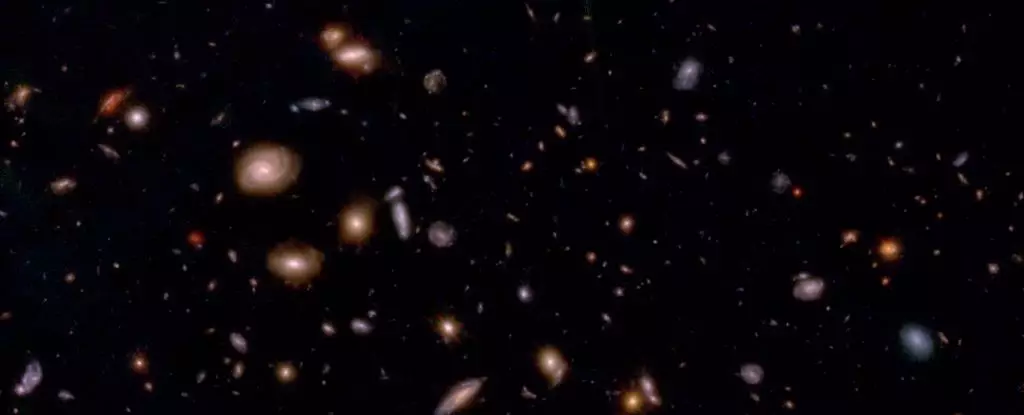When we contemplate the magnificent expanse of the universe—a realm filled with a variety of galaxies competing for our attention—one perplexing pattern emerges: a surprising number of these celestial bodies appear to rotate in unison, favoring a specific direction. This observation stands in stark contrast to our fundamental understanding of cosmic behavior, which suggests that galaxies should engage in a dance of randomness, twirling in disparate directions. The implications are monumental, signaling either an extraordinary characteristic of our universe or a profound ignorance of fundamental cosmic principles.
Why is this occurrence so significant? The discrepancy between observed galactic spins and theoretical predictions could either require a fundamental rethinking of our cosmological models or point to an undiscovered layer of reality. The astronomer Lior Shamir of Kansas State University delves into this dilemma and offers tantalizing insights that challenge established paradigms.
Born in Rotation? The Universe’s Curious Origins
One possible explanation for the synchronized spins of galaxies is the hypothesis that the universe was born with an inherent rotation. If this notion holds water, it would amplify the implications of existing theories, such as black hole cosmology, which posits that our universe might actually be part of a black hole’s interior. This perspective could endow the cosmos with a sense of coherence that current models lack, forcing scientists to reckon with a deeper truth about the cosmos.
However, the idea of a rotating universe nudges us toward the radical: If our understanding frames the universe merely as a static entity governed by gravity and dark matter, a rotating origin could signal a paradigm-shifting concept that necessitates serious contemplation. If we are indeed part of a massive black hole, our understanding of space, time, and fundamental physics would need an extensive overhaul, igniting countless imaginations and undoubtedly fueling further research.
An Illusion of Perception: The Milky Way’s Galactic Spin
The alternative explanation for the unusual state of galaxy spins posits that our own Milky Way could be creating an optical illusion. This position assumes that the motion of our galaxy significantly influences how we perceive the spin of other galaxies, thereby distorting our interpretation of cosmic rotation. This hypothesis might suggest that what seems like galactic order is an artifact of our observational standpoint rather than an omnipresent law of the cosmos.
If this interpretation is validated, it would mean our assertions about the randomness of galactic behavior are grounded in flawed reasoning. Consequently, we may need to reconsider our calibrations for measuring intergalactic distances. While this might initially seem monotonous or tedious, it opens pathways to resolving other longstanding cosmic puzzles, such as the accelerating expansion of the universe.
The Data Speaks: Empirical Evidence from Distant Galaxies
The emerging frameworks surrounding galaxy spin have gained momentum thanks to revolutionary data from missions like the James Webb Space Telescope (JWST). In a recent study, Shamir examined 263 galaxies whose light has journeyed through the vastness of space for an astonishing 5 to 10 billion years. The findings are striking: of the observed galaxies, 105 spin counterclockwise, while 158 rotate clockwise, painting a picture of imbalance where nearly two-thirds favor a singular spin direction.
What abounds in this asymmetry is not just the numerical imbalance but a deeper question of causality. For any astute observer, the difference is apparent, revealing a structure and consistency in a seemingly chaotic universe. Shamir notes, “There is no need for special skills or knowledge to see that the numbers are different.” With stunning imaging capabilities of the JWST, the public can engage with observations that were previously incomprehensible, inviting an era of collaborative cosmic inquiry.
The Call for Cosmic Re-evaluation
The implications of these findings foster critical contemplations within the scientific community. If the observed pattern harbors genuine significance, a renaissance of cosmological understanding is at hand. Researchers may need to eschew long-held beliefs, venturing into revolutionary dialogues that probe the very fabric of cosmic structure.
Moreover, the discrepancies shed light on foundational assumptions about the universe’s isotropy and homogeneity as delineated by the cosmological principle. If gravitational webs composed of dark matter resonate throughout the universe, might the characteristics of a singular galaxy—like our Milky Way—not only shape our perception but also the dynamics of galactic populations?
Such inquiries necessitate not only observational confidence but emotional courage to revise the esoterica of physics and cosmic understanding. As our gaze becomes ever more reliant on advanced astronomical technology, we may find that the cosmos, far from a sprawling chaos, dances to a rhythm yet to be fully elucidated. The universe challenges us to reconsider our cognitive frameworks, demanding innovative solutions to enigmas that span billions of light-years and myriad stars.

